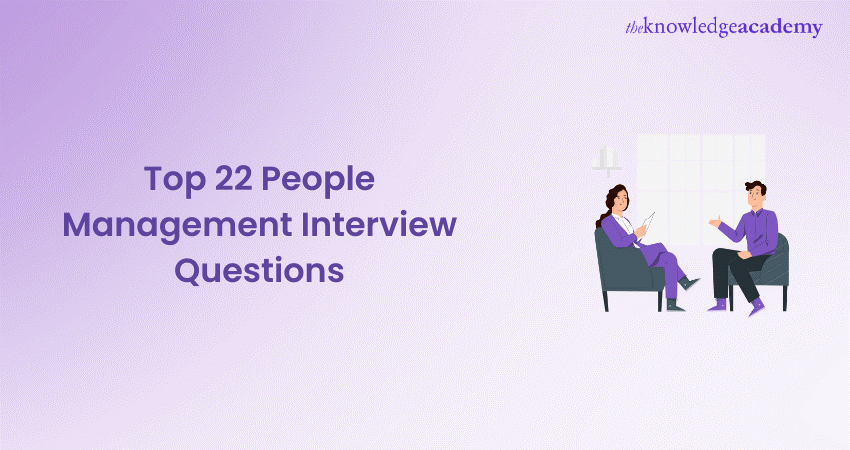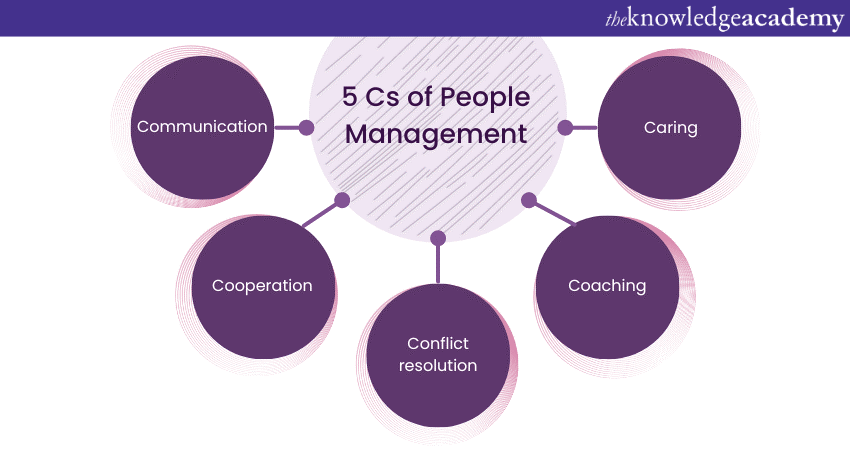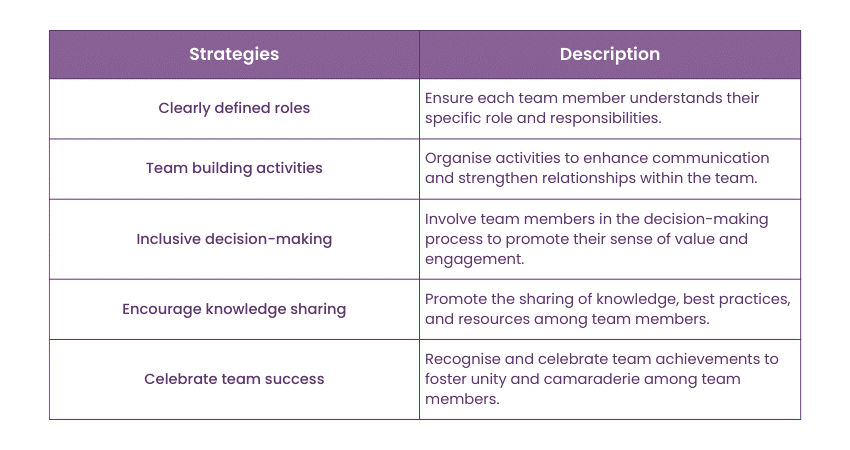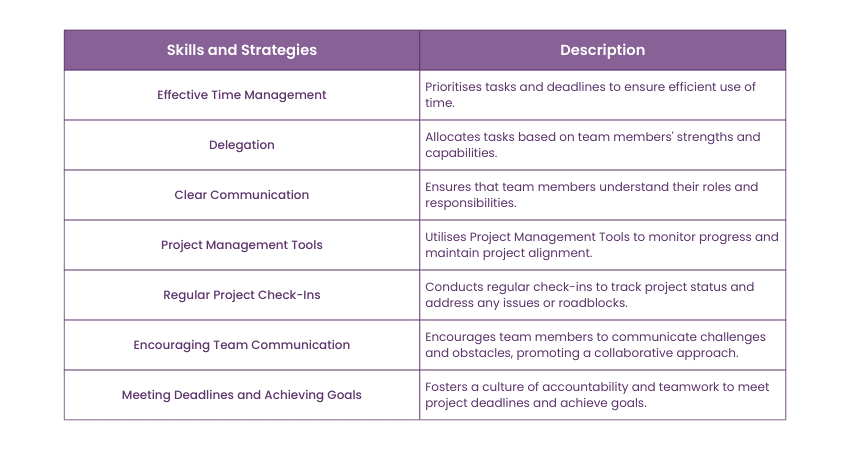We may not have the course you’re looking for. If you enquire or give us a call on 01344203999 and speak to our training experts, we may still be able to help with your training requirements.
Training Outcomes Within Your Budget!
We ensure quality, budget-alignment, and timely delivery by our expert instructors.

Explore the top 22 People Management Interview Questions in this blog. Gain insights, strategies, and real-world examples to excel in your interviews and become an excellent People Manager. From communication and conflict resolution to team motivation and diversity, this blog equips you with the knowledge to navigate the challenges of People Management Interview Questions with confidence and finesse.
Table of Contents
1) People Management Interview Questions with answers
a) Mention the 5 Cs of people management.
b) Describe the best possible methods of interaction with coworkers.
c) How do you keep yourself and your team motivated?
d) How would you help coworkers advance their careers?
e) How do you assign tasks and ensure successful delivery?
f) Why is conflict management important at work?
g) How would you acknowledge a coworker's success?
2) Conclusion
People Management Interview Questions with answer
Here are some of the most common People Management Interview Questions that you may encounter in your job interview, along with some possible answers.
1) Mention the 5 Cs of People Management.
The 5Cs of People Management stand for:

a) Communication: Open and transparent communication fosters trust, understanding, and a sense of belonging among team members. It's vital to listen actively, provide clear instructions, and encourage the team to share their ideas and problems.
b) Cooperation: Encouraging cooperation means promoting teamwork and collaboration among coworkers. A successful manager should create an atmosphere where individuals feel comfortable working together, pooling their talents and resources to achieve common goals.
c) Conflict resolution: A skilled people manager should be able to address and resolve conflicts promptly and fairly. This involves Active Listening, finding common ground, and implementing effective solutions.
d) Coaching: Coaching involves nurturing the professional growth of your team members. This means providing regular feedback, setting goals, and offering guidance to help them improve their skills and achieve their career objectives.
e) Caring: Demonstrating care and empathy for your team members goes a long way in building trust and loyalty. It involves showing an understanding of personal challenges and providing support when needed.
2) Describe the best possible methods of interaction with coworkers.
The best methods of interaction with coworkers are those that promote a positive and productive working environment. Here are some key strategies:
a) Active Listening: Pay close attention to what your coworkers say and ask clarifying questions. This not only demonstrates respect but also ensures that you fully understand their needs and problems.
b) Regular check-ins: Schedule one-on-one or team meetings to discuss progress, challenges, and goals. It offers a foundation for transparent communication, enabling you to remain in close contact with your team.
c) Use of technology: Leverage collaboration tools and platforms to facilitate communication and Project Management. Tools like Slack, Zoom, and Project Management software can streamline interactions and keep everyone on the same page.
d) Empathy: Show empathy by understanding and acknowledging the personal and professional challenges your coworkers may face. Be supportive and offer help when needed.
3) How do you keep yourself and your team motivated?
Motivation is key to maintaining productivity and job satisfaction. To keep yourself and your team motivated:
a) Set clear goals: Define clear, achievable goals that provide a sense of purpose and direction.
b) Recognise achievements: Celebrate both individual and team accomplishments. Positive reinforcement can boost morale and motivation.
c) Provide development opportunities: Offer opportunities for skill development and career advancement. Encourage continuous learning and growth.
d) Foster a positive work environment: Foster a workplace environment that values, supports, and acknowledges employees for their contributions.
4) How would you help coworkers advance their careers?
To assist coworkers in advancing their careers:
a) Identify goals: Have open conversations to understand their career aspirations and personal development objectives.
b) Offer training and mentorship: Provide access to training programs, workshops, and mentorship opportunities to help them acquire new skills and knowledge.
c) Assign challenging projects: Give them assignments that stretch their capabilities and provide growth opportunities.
d) Advocate for promotion: If a coworker is ready for a promotion, advocate on their behalf, highlighting their achievements and potential contributions to the company.
5) How do you assign tasks and ensure successful delivery?
Effective task assignment is crucial for achieving project goals. To ensure successful delivery:
a) Clearly define tasks: Communicate the objectives, scope, and expectations for each task or project.
b) Delegate appropriately: Assign tasks based on team members' strengths, skills, and workload to optimise productivity.
c) Provide resources: Ensure your team has the necessary resources, tools, and support to complete their tasks successfully.
d) Monitor progress: Regularly check in on task progress and offer guidance or assistance as needed.
6) Why is conflict management important at work?
Conflict management is essential in the workplace for several reasons:
a) Improved productivity: Unresolved conflicts can hinder productivity and team cohesion. Effective conflict management prevents disputes from derailing projects and tasks.
b) Enhanced team dynamics: Conflict resolution skills help foster healthy relationships among team members. A harmonious team is more likely to collaborate effectively.
c) Employee satisfaction: Resolving conflicts promptly and fairly promotes job satisfaction. Workers who experience acknowledgement and appreciation tend to stay more engaged and devoted to their jobs.
d) Reduced turnover: Addressing conflicts prevents employees from seeking employment elsewhere due to dissatisfaction with workplace dynamics.
e) Innovation: When conflicts are resolved constructively, it can lead to innovative solutions and ideas as diverse perspectives are considered.
7) How would you acknowledge a coworker's success?
Acknowledging a coworker's success is an important aspect of maintaining a positive work environment. You can do this in various ways:
a) Verbal Praise: Offer sincere and specific verbal praise for their accomplishments. Be sure to mention the impact of their work on the team or organisation.
b) Written recognition: Send an email or a handwritten note to express your appreciation. This provides a lasting record of their success.
c) Public acknowledgment: During team meetings or gatherings, publicly acknowledge their achievements. This not only recognises their success but also motivates others.
d) Reward and incentives: Consider offering tangible rewards or incentives for exceptional performance. This can be in the form of bonuses, extra time off, or other perks.
8) What strategies do you use to resolve conflicts within a team?
Conflict resolution within a team should be approached systematically:
a) Open communication: Promote open communication among team members, encouraging them to voice their concerns and viewpoints while actively listening to gain a better understanding of their perspectives.
b) Mediation: If necessary, act as a neutral mediator to facilitate a productive conversation between conflicting parties. Ensure that both sides have the opportunity to speak and be heard.
c) Identify underlying issues: Dig deeper to uncover the root causes of the conflict. Sometimes, conflicts may be symptomatic of larger issues within the team or organisation.
d) Agree on solutions: Help the conflicting parties find common ground and agree on solutions that address their concerns and move the team forward.
e) Follow-up: After a resolution, follow up to ensure that the agreed-upon solutions are implemented and that the conflict does not resurface.
9) Can you share an example of a time you successfully coached an underperforming team member?
Coaching an underperforming team member involves a supportive and constructive approach:
a) Identify the issue: Begin by pinpointing the areas where the team member is underperforming. Use concrete examples to illustrate your concerns.
b) Set clear expectations: Clarify your expectations for improvement and provide measurable goals or benchmarks for success.
c) Offer support and resources: Determine if the team member requires additional training, resources, or mentorship to improve performance.
d) Regular feedback: Provide ongoing feedback and constructive criticism. Highlight their progress and areas that still need improvement.
e) Encourage self-assessment: Encourage the team member to self-assess their performance and take ownership of their improvement.
10) How do you handle disciplinary issues with your team?
Disciplinary issues should be handled fairly and professionally:
a) Private discussion: Address disciplinary matters in private, one-on-one discussions to avoid embarrassing the team members.
b) Be objective: Focus on the specific behaviour or issue that needs correction.
c) Use progressive discipline: Start with a verbal warning, then escalate to written warnings if the issue persists. Ensure the consequences are clear.
d) Set a path to improvement: Clearly outline the steps the team member needs to take to rectify the issue and the timeline for improvement.
e) Document everything: Maintain a record of all disciplinary discussions and actions taken. This documentation may be necessary in the future.
11) How do you promote collaboration and teamwork among your team members?
Promoting collaboration and teamwork among team members requires an intentional effort:

a) Clearly defined roles: Make certain that every team member comprehends their specific role and duties.
b) Team building activities: Organise team-building activities and exercises to improve communication and relationships.
c) Inclusive decision-making: Involve team members in decision-making to make them feel valued and engaged.
d) Encourage knowledge sharing: Promote the sharing of knowledge, best practices, and resources among team members.
e) Celebrate team success: Recognise and celebrate achievements as a team to foster a sense of unity and camaraderie.
12) Can you describe your approach to delegation and assigning tasks to team members?
Promoting collaboration and teamwork among team members requires an intentional effort:
a) Clearly defined roles: Ensure every team member comprehends their roles and responsibilities.
b) Team building activities: Organise team-building activities and exercises to improve communication and relationships.
c) Inclusive decision-making: Involve team members in decision-making to make them feel valued and engaged.
d) Encourage knowledge sharing: Promote the sharing of knowledge, best practices, and resources among team members.
e) Celebrate team success: Recognise and celebrate achievements as a team to foster a sense of unity and camaraderie.
13) How do you handle a situation where team a member resists change?
Promoting collaboration and teamwork among team members requires an intentional effort:
a) Clearly defined roles: Ensure every team member comprehends their position and obligations.
b) Team building activities: Organise team-building activities and exercises to improve communication and relationships.
c) Inclusive decision-making: Involve team members in decision-making to make them feel valued and engaged.
d) Encourage knowledge sharing: Promote the sharing of knowledge, best practices, and resources among team members.
e) Celebrate team success: Recognise and celebrate achievements as a team to foster a sense of unity and camaraderie.
14) How do you build trust and credibility with your team members?
Establishing trust and credibility stands as a fundamental requirement for leadership effectiveness.
a) Consistency: Be consistent in your actions, decisions, and communication. Team members should know what to expect from you.
b) Transparency: Be open and honest in your communication. Share information, even if it's difficult.
c) Integrity: Lead by example and uphold high ethical standards in all your interactions.
d) Empathy: Show understanding and empathy for team members' concerns and needs.
e) Follow through: Fulfill your commitments and promises to build credibility and trust with your team.
Elevate your leadership game and nurture a winning team with our Successful People Management and Team Leadership Course. Take the first step towards success today!
15) Could you share your insights and experiences in team management?
As a team leader, the individual has extensive experience managing teams. They have successfully overseen various teams in positions such as project manager at XYZ Company. This role involved leading a team of 10 professionals responsible for delivering complex projects on time and within budget. Their responsibilities included task delegation, performance monitoring, and creating a collaborative work environment. Notably, they managed a diverse team with members from different backgrounds, showcasing their adeptness in effective communication and conflict resolution.
16) How do you motivate your team members?
The individual excels in motivating team members by cultivating a positive work environment and encouraging enthusiasm and dedication. Their approach encompasses setting clear expectations, regularly acknowledging and appreciating contributions and achievements, supporting professional development, encouraging open communication, and organising team-building activities. This multifaceted strategy fosters a sense of ownership and commitment among team members.
17) How do you set performance goals for your team members?
The individual adheres to the Specific, Measurable, Achievable, Relevant, and Time-bound (SMART) criteria when establishing performance goals for their team members. These goals are customised to each individual's strengths and areas for improvement, and the team members are actively involved in the goal-setting process. Regular check-ins and feedback sessions are integral to track progress and provide the necessary support for achieving those objectives.
18) Can you share an example of a time when you had to make a tough decision as a people manager?
In a previous leadership role, the individual encountered a challenging decision when they had to restructure the team due to budget constraints. This entailed downsizing the team and redistributing responsibilities. They initiated open and honest conversations with the affected team members, providing transparent explanations and offering support through outplacement services and references. Although it was a difficult decision, the individual made it in the best interests of the organisation and team members. This experience reinforced the importance of empathy, clear communication, and making tough decisions when necessary.
19) How do you handle performance reviews and evaluations for your team members?
The individual conducts regular performance reviews and evaluations to offer feedback, recognise accomplishments, and pinpoint areas for improvement. These reviews are interactive dialogues where team members can share their insights and concerns. The emphasis is on delivering constructive feedback, setting new performance goals, and discussing career development opportunities. The goal is to ensure team members are well-informed about their progress, receive the necessary support, and feel motivated to excel in their roles.
Unlock your team's full potential with our Staff Motivation Training and watch your business thrive. Join us today to inspire, engage, and achieve greater success together!
20) How do you ensure diversity within your team?
In promoting diversity and inclusion within their team, the individual places a strong emphasis on creating a culture of respect and equity. They actively seek diverse perspectives and backgrounds when recruiting and consider diversity in team composition. Consistent training and awareness programs are implemented to cultivate an atmosphere where every team member feels valued, heard, and respected. The individual also ensures that policies and practices support diversity and inclusion, actively addressing bias or discrimination.
21) How do you promote employee engagement and job satisfaction?
The individual prioritises employee engagement and job satisfaction by actively involving team members in decision-making, seeking their input, and recognising their contributions. They create opportunities for skill development, offer a supportive work environment, and celebrate team achievements. Regular feedback and performance reviews provide avenues for improvement, ensuring that team members are motivated and satisfied with their roles.
22) What strategies do you employ to effectively handle team leadership alongside juggling multiple projects and deadlines, all while maintaining your priorities?

When managing multiple projects and deadlines while leading a team, the individual relies on effective time management, delegation, and clear communication. They set priorities, allocate tasks based on team members' strengths, and use Project Management tools to monitor progress. Regular project check-ins are instrumental in maintaining project alignment and progress. Additionally, they encourage their team to communicate any challenges or roadblocks, promoting a collaborative approach to meeting deadlines and achieving project goals.
Ready to lead with confidence and excellence? Join our Leadership Training and empower your potential today.
Conclusion
Mastering People Management Interview Questions is the key to success in today's workplaces. These questions cover essential areas like teamwork, conflict resolution, and leadership. By understanding and preparing for these interview questions, you'll be well-equipped to excel as a people manager. Remember, effective People Management is about building strong teams, resolving conflicts, and fostering diversity and engagement. So, keep these insights in mind as you step into your next interview.
Ready to transform into a confident and effective leader? Start honing your Leadership Skills today and unlock your full potential with our Leadership Skills Course now!
Frequently Asked Questions
Upcoming Business Skills Resources Batches & Dates
Date
 Successful People Management and Team Leadership
Successful People Management and Team Leadership
Fri 7th Jun 2024
Fri 2nd Aug 2024
Fri 4th Oct 2024
Fri 6th Dec 2024







 Top Rated Course
Top Rated Course



 If you wish to make any changes to your course, please
If you wish to make any changes to your course, please


